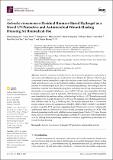| dc.contributor.author | Xu, Chunyuhang | |
| dc.contributor.author | Chen, Siyu | |
| dc.contributor.author | Liu, Tiange | |
| dc.contributor.author | Zhu, Haowen | |
| dc.contributor.author | Kuo, Chien-Liang | |
| dc.contributor.author | Zhou, Zhuoyu | |
| dc.contributor.author | Chen, Guo | |
| dc.contributor.author | Chin, Fion Wei Lin | |
| dc.contributor.author | Yang, Xin | |
| dc.contributor.author | Huang, Dejian | |
| dc.date.accessioned | 2025-06-10T16:50:40Z | |
| dc.date.available | 2025-06-10T16:50:40Z | |
| dc.date.issued | 2025-05-08 | |
| dc.identifier.uri | https://hdl.handle.net/1721.1/159382 | |
| dc.description.abstract | Antrodia cinnamomea is widely known for its bioactive properties, particularly in
anti-cancer, anti-inflammatory, and antibacterial areas. Despite the full use of the bioactive
compounds from its fruiting body, high-value residues remain largely underexploited. This
study presents a novel one-pot gel formation method, utilizing cinnamomea cellulose-riched
residues to create hydrogels as an effective wound-healing dressing. The hydrogels derived
from these residues show desirable properties, including non-drying characteristics, antibacterial activity against Staphylococcus aureus ATCC 1768, and cytocompatibility. Residual
bioactive compounds, such as Antcin-K, Dehydroeburicoic acid, and (25S,R)-Antcin H,
were identified in the residues, adding to the hydrogel’s efficacy. A UVB irradiation model
was employed to evaluate the protective effects of the residues on UVB-damaged HaCaT
skin cell lines, with an IC50 of 0.045 mg/mL. The results indicated that A. cinnamomea
residue extracts reduced the upregulation of MMP-1, MMP-2, MMP-3, MMP-7, and MMP-9
proteins caused by UVB exposure, suggesting high UV-protective activity. Additionally,
antibacterial tests on Staphylococcus aureus strains, including Staphylococcus ATTC 1768,
showed promising results, with inhibition zones ranging from 10.64 to 12.11 mm. In summary, Antrodia cinnamomea residue hydrogels combine UV protection with antimicrobial
activity, making them a promising candidate for medical applications, particularly as a
wound-healing dressing. | en_US |
| dc.publisher | Multidisciplinary Digital Publishing Institute | en_US |
| dc.relation.isversionof | http://dx.doi.org/10.3390/ijms26104496 | en_US |
| dc.rights | Creative Commons Attribution | en_US |
| dc.rights.uri | https://creativecommons.org/licenses/by/4.0/ | en_US |
| dc.source | Multidisciplinary Digital Publishing Institute | en_US |
| dc.title | Antrodia cinnamomea Residual Biomass-Based Hydrogel as a Novel UV-Protective and Antimicrobial Wound-Healing Dressing for Biomedical Use | en_US |
| dc.type | Article | en_US |
| dc.identifier.citation | International Journal of Molecular Sciences 26 (10): 4496 (2025) | en_US |
| dc.contributor.department | Koch Institute for Integrative Cancer Research at MIT | en_US |
| dc.relation.journal | International Journal of Molecular Sciences | en_US |
| dc.identifier.mitlicense | PUBLISHER_CC | |
| dc.eprint.version | Final published version | en_US |
| dc.type.uri | http://purl.org/eprint/type/JournalArticle | en_US |
| eprint.status | http://purl.org/eprint/status/PeerReviewed | en_US |
| dc.date.updated | 2025-05-27T12:54:11Z | |
| dspace.date.submission | 2025-05-27T12:54:11Z | |
| mit.journal.volume | 26 | en_US |
| mit.journal.issue | 10 | en_US |
| mit.license | PUBLISHER_CC | |
| mit.metadata.status | Authority Work and Publication Information Needed | en_US |
